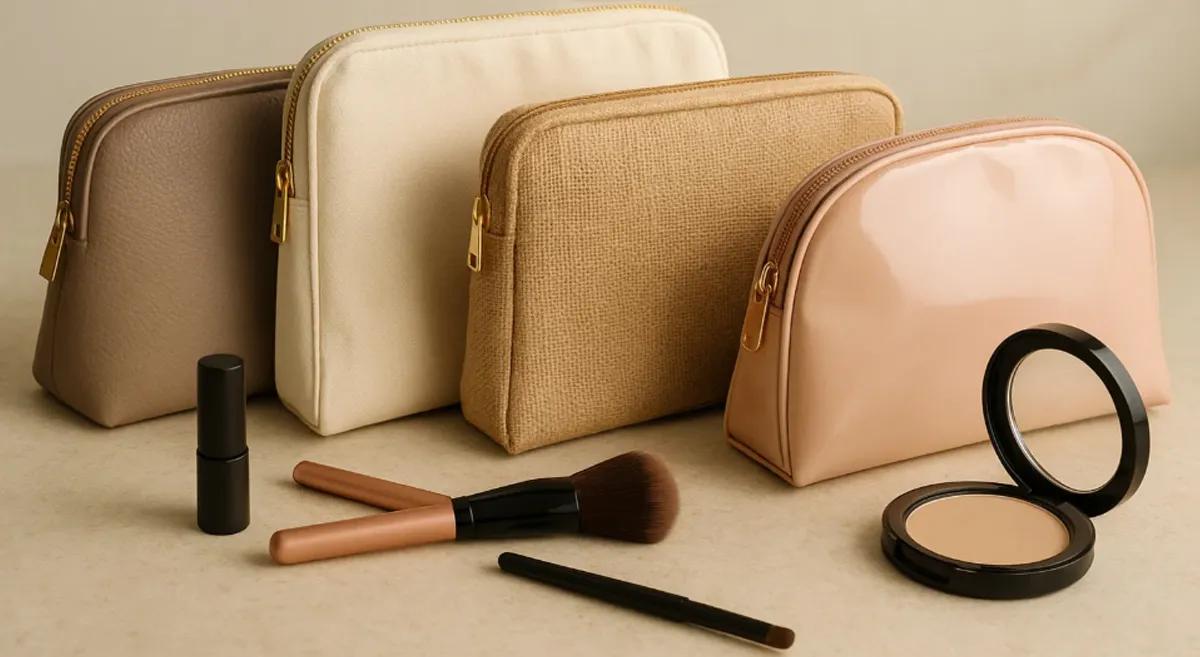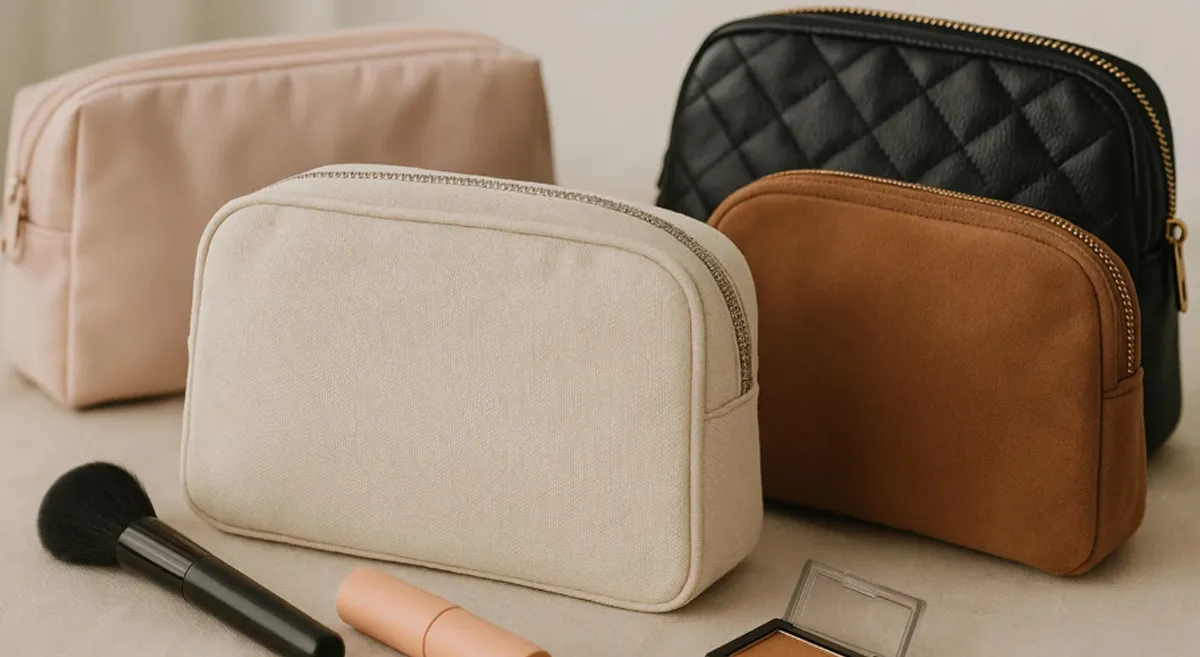Have you ever bought a makeup bag that looked beautiful on the outside, only to realize a few months later that it just does not work? Maybe the zipper broke, maybe the fabric got stained with foundation that never washed out, or maybe the bag started peeling and cracking.

The problem often is not the design—it is the material. A makeup bag’s material decides whether it will last for years or fall apart after a season. It affects the durability, the look, the weight, the price, and even the brand impression if you are sourcing them for resale.
So, the big question is: what material is best for makeup bags?
In this complete guide, we will dive deep into the different materials used for makeup bags, explore their pros and cons, compare them side by side, share real user stories, and help you figure out which material is right for your needs—whether you are a traveler, a daily makeup user, a beauty brand, or someone shopping for wholesale.
Why Material Defines a Makeup Bag
It is tempting to think of a makeup bag as just a pouch with a zipper, but the material makes all the difference. Here is why:
- Durability – Cheap polyester may look fine for a month, but rip after heavy use. High-density nylon, on the other hand, can survive years of travel.
- Protection – Powders, creams, and lipsticks are fragile. The right material keeps them safe from pressure and leaks.
- Waterproofing – A water-resistant bag saves you from disasters like spilled toner or melted lipstick.
- Cleaning – Some fabrics wipe clean in seconds; others stain permanently.
- Style – Shiny PU leather screams luxury, while canvas says eco-friendly and casual.
- Cost & Positioning – Materials signal brand identity. Polyester is for mass market. PU-coated nylon is for premium. RPET is for eco-conscious.

A Deep Dive Into Makeup Bag Materials
Nylon
- Pros: Lightweight, tough, water-resistant, flexible, affordable.
- Cons: Oil stains are hard to remove, thin nylon can feel cheap, not eco-friendly.
- Best for: Travelers, daily users.
Polyester
- Pros: Budget-friendly, durable, excellent for printing.
- Cons: Less water-resistant, lower eco value.
- Best for: Budget bags, promotions, wholesale.
PU-Coated Nylon
- Pros: Waterproof, scratch-resistant, looks premium, very durable.
- Cons: Higher cost, PU can peel if quality is low.
- Best for: Premium brands, travel makeup bags.
PU Leather
- Pros: Stylish, premium appearance, water-resistant.
- Cons: Can peel, less breathable, more expensive.
- Best for: Luxury bags, gift markets.
Canvas or Cotton
- Pros: Eco-friendly, soft, perfect for printing, lifestyle appeal.
- Cons: Absorbs liquids, stains easily, not waterproof.
- Best for: Eco brands, casual users.
PVC, TPU, or EVA
- Pros: Completely waterproof, easy to clean, transparent.
- Cons: Can yellow or harden, not eco-friendly.
- Best for: TSA-approved travel bags, promotions.
Mesh
- Pros: Lightweight, breathable, lets you see contents.
- Cons: Tears easily, not waterproof.
- Best for: Makeup brush holders, compartments.
Eco-Friendly Options (RPET, Tyvek, Washable Paper)
- RPET: Made from recycled plastic bottles, durable, eco-friendly.
- Tyvek: Paper-like but tear-resistant, trendy.
- Washable Paper: Unique, sustainable, washable.
- Best for: Sustainable fashion brands, eco-conscious buyers.
Comparison Table
| Material | Waterproof | Durability | Easy to Clean | Eco-Friendly | Cost | Best For |
|---|---|---|---|---|---|---|
| Nylon | Moderate | High | Moderate | Low | Medium | Travelers, daily users |
| Polyester | Low | Moderate | Low | Very Low | Low | Budget bags, promotions |
| PU-Coated Nylon | High | Very High | High | Low | Mid | Premium travel, cosmetic brands |
| PU Leather | High | Moderate | Moderate | Very Low | High | Luxury, gift market |
| Canvas/Cotton | Very Low | Low | Low | High | Medium | Eco, casual, lifestyle brands |
| PVC/TPU/EVA | Very High | Moderate | High | Very Low | Low | TSA, travel, promotions |
| RPET/Tyvek | Moderate | Moderate | Moderate | Very High | Medium | Sustainable fashion, branding |
Choosing the Right Material
- Frequent travelers: PU-coated nylon or transparent TPU.
- Everyday users: Nylon or polyester.
- Luxury buyers: PU leather.
- Eco-conscious consumers: RPET, Tyvek, washable paper.
- Brands: Polyester for budget promotions, PU-coated nylon for premium lines.
Eco-Friendly Trends
Sustainability is quickly becoming a big deal in the makeup bag world. Shoppers today care about more than looks—they also want to know if the bag is safe for the planet.
One of the most popular choices is RPET, a recycled polyester made from plastic bottles. It is strong, durable, and gives waste a second life instead of sending it to landfills.
Then there are stylish newcomers like Tyvek and washable paper. Both are lightweight, modern, and have that eco-friendly vibe that young buyers love. They are practical but also make a fashion statement.
Major beauty brands are already using these materials in gift sets and promotional lines. Why? Because eco-friendly bags are no longer just a trend. They are a real reason people choose one brand over another.
Eco-Friendly Material Comparison
| Material | Main Features | Advantages | Limitations | Best For |
|---|---|---|---|---|
| RPET | Recycled polyester from plastic bottles | Durable, water-resistant, reduces waste | Slightly higher cost | Mass brands, sustainable campaigns |
| Tyvek | Paper-like synthetic, tear-resistant | Lightweight, trendy look, unique feel | Less luxurious finish | Young buyers, modern eco brands |
| Washable Paper | Natural fiber with coating | Washable, eco-friendly, stylish | Limited heavy-duty durability | Fashion-focused eco products |
| Organic Cotton | Grown without pesticides | Natural, biodegradable, brand-friendly | Absorbs stains, not waterproof | Eco lifestyle, casual users |
| Biodegradable TPU | Plant-based or modified plastic | Clear, flexible, partially compostable | New tech, limited availability | Eco travel bags, innovative brands |
Care and Maintenance Tips
Taking care of your makeup bag is just as important as choosing the right one. Different fabrics need different care methods, and if you handle them properly, your bag will last longer and look fresher.
Makeup bags made of nylon or PU-coated nylon are the easiest to maintain. Most of the time, all they need is a quick wipe with a damp cloth to remove dust or makeup smudges. If you spill liquid foundation inside, a gentle soapy cloth usually does the trick. The only thing to watch out for is heat—keep them away from hair dryers, radiators, or direct sunlight, as too much heat can make the PU coating peel or warp.
Polyester bags can handle a little more water. If they get dirty, you can soak them in cool water with mild soap and gently hand wash them. Just remember to avoid bleach or strong detergents because those will damage the fibers and fade the print. After washing, always let them air dry. Using a tumble dryer may shrink the fabric or cause the surface to lose its finish.
For canvas or cotton makeup bags, a more careful approach works best. They can be hand washed with mild detergent, but they absorb stains quickly, especially from oils and creams. If you get a lipstick or mascara mark, dab the spot first with baking soda paste or a gentle stain remover before washing. Once cleaned, let the bag air dry to keep its shape and prevent shrinkage. If you want extra protection, spraying a fabric protector can help resist future stains.
PVC, TPU, or EVA bags are probably the simplest to care for. Since they are plastic-based, you can just wipe them with a damp cloth, makeup remover wipe, or even a baby wipe. They are not fans of the sun, though. Leave them in direct sunlight for too long and they may turn yellow, harden, or crack. Also, try not to fold them tightly, as the creases can become permanent.
Finally, there are the eco-friendly fabrics like RPET, Tyvek, and washable paper. These need a gentler touch. RPET is fairly durable, so you can rinse it lightly if needed, but avoid scrubbing it too hard. Tyvek has a paper-like texture and should only be wiped down with a damp cloth. Washable paper is a little more forgiving—you can rinse it or lightly hand wash it, then let it dry flat so it keeps its shape. With all three, the goal is to clean only when necessary to extend their lifespan.
In short, every material has its own personality when it comes to care. Nylon and PVC love a quick wipe, polyester and canvas like gentle hand washing, and eco fabrics need special attention. Treat them right, and your makeup bag will not only last longer but also keep looking good trip after trip.
Conclusion
The best material for makeup bags depends on what you need. Nylon and polyester are great for everyday use, PU leather gives a luxury feel, PVC and TPU are perfect for travel, and RPET or Tyvek are ideal for sustainable choices.
There is no one “perfect” material—it is about matching the material to your lifestyle, budget, or brand identity.
At Initi, we are not just sellers—we are a direct manufacturer of custom makeup bags. With over 15 years of experience, we design and produce makeup bags in nylon, polyester, PU leather, PVC, canvas, RPET, Tyvek, and more.
- OEM/ODM available
- Custom logo printing and private labeling
- Wholesale pricing direct from factory
- Eco-friendly materials for sustainable brands
Whether you need travel makeup pouches, promotional giveaways, or premium branded bags, we can make it happen.
FAQs
Which material lasts the longest?
PU-coated nylon offers the best durability.
Which is easiest to clean?
PVC and TPU wipe clean in seconds.
Which material is best for eco-friendly brands?
RPET, Tyvek, and washable paper.
What do luxury brands prefer?
PU leather or high-quality coated nylon.
Which works best for TSA-approved travel bags?
Transparent PVC/TPU pouches.




